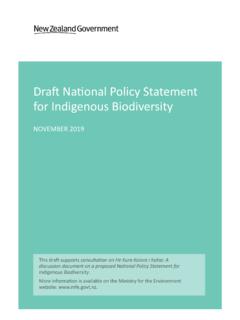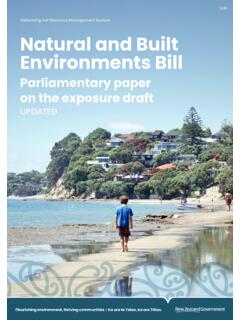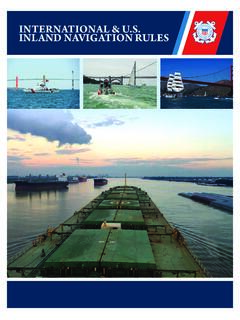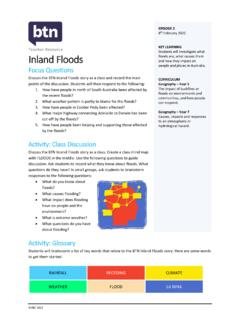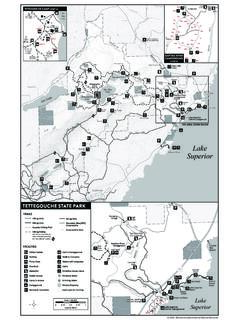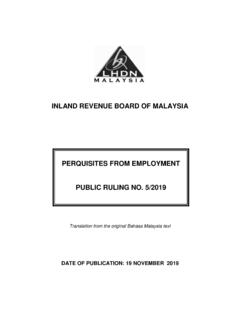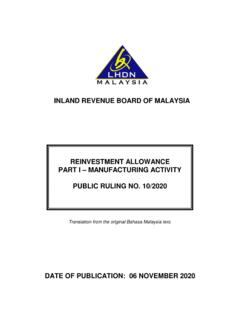Transcription of Defining ‘natural wetlands’ and ‘natural inland wetlands’
1 Defining natural wetlands' and natural inland wetlands'. Guidance to support the interpretation of the National Policy Statement for Freshwater Management 2020 and the Resource Management (National Environmental Standards for Freshwater). Regulations 2020. Disclaimer The information in this publication is, according to the Ministry for the Environment's best efforts, accurate at the time of publication. The Ministry will make every reasonable effort to keep it current and accurate. However, users of this publication are advised that: The information does not alter the laws of New Zealand, other official guidelines, or requirements. It does not constitute legal advice, and users should take specific advice from qualified professionals before taking any action based on information in this publication.
2 The Ministry does not accept any responsibility or liability whatsoever whether in contract, tort, equity, or otherwise for any action taken as a result of reading, or reliance placed on this publication because of having read any part, or all, of the information in this publication or for any error, or inadequacy, deficiency, flaw in, or omission from the information in this publication. All references to websites, organisations or people not within the Ministry are for convenience only and should not be taken as endorsement of those websites or information contained in those websites nor of organisations or people referred to. This document may be cited as: Ministry for the Environment. 2021. Defining natural wetlands' and natural inland wetlands'.
3 Wellington: Ministry for the Environment. Published in September 2021 by the Ministry for the Environment Manat M Te Taiao PO Box 10362, Wellington 6143, New Zealand ISBN: 978-1-99-003376-6. Publication number: ME 1590. Crown copyright New Zealand 2021. This document is available on the Ministry for the Environment website: Contents 1 Purpose 5. Legal status of guide 5. New terms introduced 5. Future amendments to the wetland definitions 5. 2 Policy intent and summary of the NPS-FM and Freshwater NES wetland provisions 6. New policies and regulations to protect natural wetlands' 6. Application of the New Zealand Coastal Policy Statement 7. The NPS-FM protects the of extent and values of every individual natural inland wetland 7. Natural wetland' applies regardless of wetland condition 8.
4 Natural wetland' applies regardless of wetland size 8. 3 Wetland definitions in the RMA 1991 and NPS-FM 9. Wetlands in the RMA 9. Natural wetlands' 9. Natural inland wetlands' 10. A process to assess natural wetland' and natural inland wetland' status 11. 4 Wetland delineation protocols 12. Using the protocols to resolve uncertainty or dispute 12. Limitations of the WDPs 12. Further assessment to determine a natural wetland' 13. 5 Wetlands constructed by artificial means 14. Why they are excluded 14. Exceptions to this exclusion 14. Examples of wetlands constructed by artificial means 14. No timeframe for consideration 15. 6 Induced wetlands 16. Examples of induced wetlands 16. Previous advice retracted 16. 7 Geothermal wetlands 18. 8 Improved pasture 19.
5 Intent of this exclusion 19. Defining natural wetlands' and natural inland wetlands' 3. Assessing temporary rain-derived pooling 19. Timeframes for assessing this exclusion 20. Self-established exotic pasture species in areas that are not under active management 20. Further guidance to come 21. 9 Providing protection for all other wetlands 22. 10 Distinguishing wetlands from other waterbodies 23. 11 Coastal wetlands 24. 12 Next steps 25. Figures Figure 1 Assessing natural wetland' and natural inland wetland' status under the NPS-FM 11. 4 Defining natural wetlands' and natural inland wetlands'. 1 Purpose The National Policy Statement for Freshwater Management (NPS-FM) 2020 introduced the terms natural wetlands' and natural inland wetlands'. This guide shows how to apply those definitions and clarifies the policy intent.
6 The full definitions are in section 3 below. This guide also covers common queries about the definitions and recent relevant case law. The terms natural wetlands' and natural inland wetlands' are also used in the Resource Management (National Environmental Standard for Freshwater) Regulations 2020 (Freshwater NES) and the Resource Management (Stock Exclusion) Regulations 2020 (Stock Exclusion regulations). For a quick guide to Defining natural wetlands', for the purposes of the NPS-FM and NES-F, see the flowchart in section 3. Legal status of guide While this guide cannot provide legal interpretation of RMA national instruments or overrule legal decisions, it clarifies what the Ministry for the Environment's policy intends. New terms introduced The guide introduces two new terms not used in the NPS-FM.
7 These terms have no legal status and are used to help interpret the NPS-FM. They are: inland saline wetland induced wetland. Future amendments to the wetland definitions The Ministry has received feedback that applying the definition of natural wetland' in the NPS- FM can cause problems. For example, some heavily modified, pasture-dominated wetlands have been captured as natural wetland' areas even though part (c) of the definition seeks to exclude these areas (see definition in below). This is not the intention and could unnecessarily restrict changes in land use and development in these areas. As of the date of publication of this guide, changes to the Freshwater NES and NPS-FM are being considered to correct this. Amendments to the definition of natural wetland' under the NPS-FM may be one way to resolve implementation challenges.
8 This guide advises how to apply the current definitions. It will be amended if any changes are made. Defining natural wetlands' and natural inland wetlands' 5. 2 Policy intent and summary of the NPS-FM and Freshwater NES wetland provisions New Zealand has lost most of its wetlands, and wetland loss is ongoing, with almost 5400. hectares of freshwater wetland lost to non-natural causes between 1996 and 2018. 1 Many of those remaining are rare and valuable ecosystems. New policies and regulations to protect natural wetlands'. The Essential Freshwater package came into force in September 2020. It included the Freshwater NES, the NPS-FM and Stock Exclusion regulations. The package introduced policies and regulations to protect natural wetlands' with nationally consistent standards.
9 The NPS-FM. applies to natural inland wetlands' while the Freshwater NES and Stock Exclusion regulations refer to natural wetlands' (see section 3). The term natural wetlands' does not include all wetlands in New Zealand, so some are not affected by the Essential Freshwater regulations. Under sections 6(a) and 6(c) of the Resource Management Act 1991 (RMA) councils have to recognise and provide for matters of national importance, such as the preservation of the natural character of wetlands, the protection of areas of significant indigenous vegetation and significant habitats of indigenous fauna. This would include some wetlands not covered by the natural wetlands' definition due to the broader definition of a wetland under section 2 of the RMA.
10 The Freshwater NES regulates potentially damaging activities in or near natural wetlands to make sure there is no further loss or degradation of natural wetlands. From 1 July 2025 the Stock Exclusion regulations will control stock access to natural wetlands larger than 500 square metres on low slope land. The wetland policies in the 2020 NPS-FM are intended to protect both the extent and values of all remaining natural inland wetlands, regardless of their size and condition (see Policy 6. below). NPS-FM (2020) Policy 6: There is no further loss of extent of natural inland wetlands, their values are protected, and their restoration is promoted. For more information about council obligations for natural inland wetlands, see the Essential Freshwater wetlands factsheet 2.

